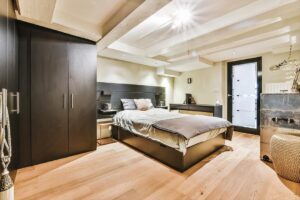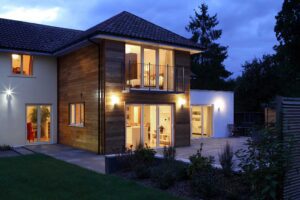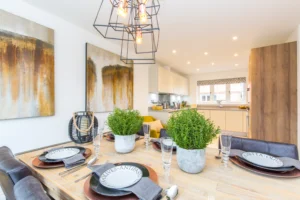Use our guide to explore how interior design influences wellness and how to create a home that truly supports your lifestyle.
Imagine stepping into your home after a long day. Ideally, it should be a space that welcomes you with comfort, calm, and joy.
However, the demands of everyday life often take precedence—whether it’s juggling family responsibilities, managing chores, or keeping on top of finances.
While we can’t eliminate life’s stresses, the way we design our homes can significantly impact our mood and overall well-being.
Here, we explore the key elements of home design that contribute to a happier, healthier living environment and how you can incorporate them into your own space.
The Key Elements of a Happy Home
Through extensive research into what makes a home a place of wellbeing, we’ve identified six core factors that contribute to happiness in the home:
- Secure – Provides shelter, safety, and stability
- Nourishing – Supports a healthy lifestyle
- Adaptable – Evolves to meet changing needs
- Relaxed – Creates a sense of calm and comfort
- Connected – Encourages interaction and togetherness
- Personal – Reflects your personality and style
Secure: A Sense of Stability
Feeling secure in your home is essential for peace of mind. Homeowners may worry about mortgage payments and property upkeep, while renters can feel uncertain about long-term stability.
While financial factors are key, design choices can also help create a sense of security.
Making considered improvements can add both value and stability for homeowners. If you’re looking to enhance your home through design, residential architects can help you explore options that align with your goals.
For renters, adding personal touches like soft furnishings, rugs, and artwork can create a sense of belonging, even in a temporary space.
Nourishing: A Healthy Living Environment
A nourishing home promotes health through good lighting, ventilation, and acoustics. One of the most impactful elements is natural light, which has been proven to improve mood and overall wellbeing.
If your home lacks natural light, consider installing skylights or larger windows. These can transform dark spaces and help regulate sleep cycles. Even small changes, like strategically placing mirrors to reflect light or using sheer curtains, can make a difference.
Adaptable: A Home That Grows With You
Life is constantly evolving, and a home that adapts to your needs can reduce stress and enhance comfort.
Flexibility is key whether you’re welcoming a new family member, setting up a home office, or accommodating an ageing relative.
Adding an extra bedroom or reconfiguring existing space can be a game-changer for growing families. Clever storage solutions, like modular shelving and under-bed drawers, help maximise space without requiring major renovations.
Relaxed: Creating a Calming Atmosphere
Your home should be a place where you can unwind. Colour has a powerful effect on emotions—soft, muted tones can promote relaxation, while bolder shades can energise a space.
Before committing to a colour scheme, experiment with paint samples to find what makes you feel most at ease.
Beyond colour, prioritising comfort in key areas like the bedroom and living room is essential. Invest in a quality mattress, layer textures with throws and cushions, and consider lighting options that create a soothing ambiance.
Connected: Spaces for Interaction
A home isn’t just about aesthetics—it’s about the people in it. Creating spaces that foster connection can enhance relationships and overall happiness.
If you love entertaining, an open-plan kitchen and dining area can encourage gatherings. If cosy evenings with close family and friends are more your style, opt for plush sofas and intimate seating arrangements.
The key is to design your home around how you love to interact with others.
Personal: A Reflection of You
A home that feels truly yours should reflect your personality. Whether through bold colour choices, statement furniture, or meaningful décor, don’t be afraid to embrace what you love.
Look for inspiration from designers and creatives who celebrate individuality. Social media platforms like Instagram and Pinterest offer endless ideas for bringing character into your home.
The goal is to design a space that makes you feel happy every time you walk through the door.
At DMS Architects, we’re passionate about designing homes that enhance everyday life.
If you’re considering changes to your space, get in touch to discuss how we can help bring your vision to life.











